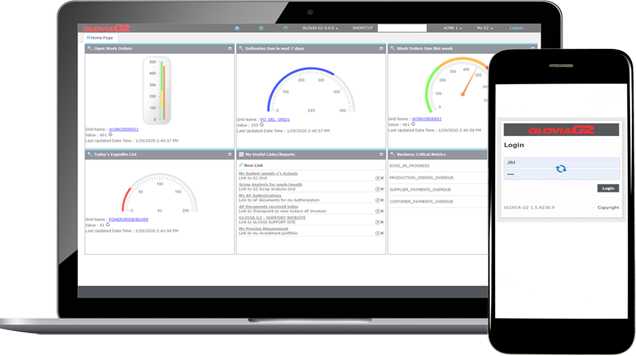Ted Rohm, Senior ERP Analyst from TEC gives his opinion on GLOVIA G2, our Manufacturing ERP Product. “CrescentOne, from CrescentOne., has a long history of supporting manufacturers that require real-time control over their operations. GLOVIA G2 has its roots in a solution from Xerox named ChESS MRP II, which was first released in 1990.
Click Here to Download the Report
The solut complex enterprise requirements of Fujitsu and manufacturing industries such as automotive, aerospace and defense, industrial machinery, and telecommunications. Fujitsu was so impressed with the product that they eventually acquired 100% control of it in 2000.
“GLOVIA G2 was built from day one to be a real-time solution for manufacturing. GLOVIA G2 customers have always been able to process material requirements planning (MRP), master production schedule (MPS), and advanced planning and scheduling (APS) operations multiple times a day.”
-Ted Rohm, Senior ERP Analyst, TEC
The CrescentOne solution was built to solve complex manufacturing requirements and to process transactions in real time. These are important differentiating characteristics of GLOVIA G2. The majority of other ERP solutions currently on the market were built first as financial solutions while others were built around batch transaction processing. The manufacturing operations components of these systems were then built on top of these financial solutions, which means that the financial operation is the primary focus of all operations and the manufacturing operations are more of an afterthought. Additionally, many earlier ERP systems were built to push transactions in batch mode across the system. GLOVIA G2 was built from day one to be a real-time solution for manufacturing. GLOVIA G2 customers have always been able to process material requirements planning (MRP), master production schedule (MPS), and advanced planning and scheduling (APS) operations multiple times a day. Users of other ERP systems must run these processes overnight or during non-peak hours to make sure the system isn’t brought to its knees.
In this report, we will look at three areas of GLOVIA G2 that help support today’s real-time manufacturing requirements. These are a lean user experience, the shop floor dispatch tool, and the powerful factory planning tool for APS.
Lean User Experience
The GLOVIA G2 user experience is designed, like the underlying ERP system, to support lean operations. The key thesis of lean manufacturing is to eliminate waste in the manufacturing process. Similarly, critical aspects of the GLOVIA G2 user interface have been built to eliminate wasting time in the system to get things done. The GLOVIA G2 home page (figure 1) provides a user with a set of customizable panes that provide access to the functions in the system.

Figure 1. GLOVIA G2 home page
A user can set up as many or as few of these panes as required to get her/his job done on a daily basis. As shown in figure 1, users will often have a messages pane, a pane for common tasks, and other panes grouped as needed by the user. One pane in the figure shows the G2 Insights that this particular user should be monitoring. The G2 Insights are notifications pushed down to the user on a real-time basis. This pane is then populated with the latest tasks that the user should be monitoring.

Figure 2. Data grids
The figure above shows the data grids, which are an underlying component of the user interface. GLOVIA G2’s data grids look like Excel spreadsheets, but they are even more powerful. A data grid lets a user create a personalized view of the data. A user is able to filter the results by any column, sort data in ascending or descending order with a click of the column header, change the order of columns displayed, and group the data by one of the columns. The data can be downloaded to Excel for further manipulation. Most of these operations can be performed via drag-and-drop functions. Each grid is set up with a refresh rate, but the user can refresh the grid at any time.
A user can right-click on an object to see available operations on an element in the data grid. These functions include sending messages or emails, or performing some other function within GLOVIA G2. In the case of work orders (figure 2 above), these functions might include work order maintenance, work order inquiry, work order completion, and inventory inquiry.
An administrator can set up which functions can be personalized for each user. Some users may be able to view or hide only certain columns or perform only specific operations within a data grid. And the data grids can display a chart beside the data to visualize the data being viewed, as shown in figure 3.

Figure 3. Sales order grid with pie chart
The shop floor dispatch list is built on the GLOVIA G2 data grid technology, allowing for all the customization needed to manage dynamic production activities. -Ted Rohm, Senior ERP Analyst, TEC
Shop Floor Dispatch
The shop floor dispatch tool has been built to be the “one stop shop” for recording all production activity against work orders and repetitive schedules within GLOVIA G2. The screen was designed for touch screens and point-and-click navigation. All production activities are available from this screen including clock-on/clock-off, component scrap, operation scrap, assembly scrap, operations/item completions, inspection results/alerts, component verification, availability and issues, tooling verification, order release, and order inquiry/maintenance. Figure 4 shows a dispatch list where material availability is displayed for an item via a handheld scanner.

Figure 4. Shop floor dispatch screen
The shop floor dispatch list is built on the GLOVIA G2 data grid technology, allowing for all the customization needed to manage dynamic production activities. This application was built for operators on the factory floor to give visibility into all the jobs planned for the individual’s workstation.
A user might need to quickly change the filters on the work orders displayed to perform all operations using a particular tool on hand. Or, an operator might need to switch to another set of operations due to a material shortage that occurred because of excess scrap. The flexibility of the shop floor dispatch tool provides users with the proper tools to do the job and minimizes the keystrokes needed to record activity. In fact, many of the operations require little to no user input.
In addition to the standard data grid capabilities, the shop floor dispatch tool adds additional graphical indicators to highlight the important information for the user. The color displayed for a work order can change depending on multiple tolerance limits set to low, medium, or high. Un-released orders will be shown with a gray background if not late. The overall result is that users get simple screens that present them with the right orders and the right options for executing the manufacturing activity at hand.
Factory Planning
GLOVIA G2 Factory Planning is an advanced planning system (APS) that takes into account multiple constraints to generate an optimized production schedule. The system can take into account any constraints on material, machine capacity, setup and runtime capacity, labor skill sets, and machine tooling. Factory Planning determines the production schedule based on these finite constraints to accurately determine capable-to-promise (CTP) commitments for customer orders. Many ERP systems and their planning tools are able to determine only available-to-promise (ATP) dates; these systems assume infinite capacity while other systems offer CTP tools that lack the sophisticated capabilities of the GLOVIA G2 system.
Users have extensive control over the information that they see in factory planning. Each of the various panes of information can be configured to suit an organization’s and individual’s unique needs. The views or panes of information include an order pane, a seiban order pane, a planning board, a teams pane, a team/skill workload pane, and an inventory pane. Figure 5 shows the order, workload, and inventory panes. This is a great example of how the system makes it easier to manage production schedule problems. In figure 5, one can see that there is a problem with the inventory on one of the items on the order. From here, it’s easy to jump to that particular item and take the necessary action to get rid of the inventory shortage.

Figure 5. Factory planning screen with multiple panes
Factory planning is a memory-resident data model that is a seamless extension of the GLOVIA G2 system. This means that any events posted to the GLOVIA G2 system will be reflected in real time in factory planning. For example, any events recorded in shop floor dispatch will impact factory planning in real time. If a user receives inventory, completes a manufacturing job, or a machine goes offline, the event is immediately visible in factory planning. In many systems, these events will be loaded into the planning tool via some batch update facility and inevitably lead to inaccurate schedules.
But probably the most impressive capabilities in factory planning are the extensive array of planning scenarios supported by factory planning. These include:
- Scheduling directions—forward, backward, and mixed
- Flexible interactive settings of constrained resources
- Simultaneous checking of resources (capacity, inventory, and tools)
- Full optimization to reduce setup times
- Full optimization to improve the flow through complex processes
- Instant re-optimization after machine breakdown or inventory shortage
- Planning based on labor skills, resources, and/or team-based manufacturing
- Scheduling groups—used for mixed-mode manufacturing scenarios where orders for certain items have priority over order for other items
- Multi-pallet / Product carrier planning—plans for machines where multiple pallets of items are placed on tools and prepared for sequential processing in the machine
Figure 6 shows how some of these scheduling parameters are set up in factory planning. This figure shows various scenarios and the flexibility in setting the parameters against those scenarios. Here a planner can also set workday patterns. Workday patterns can be assigned at the enterprise, machine, tools, labor skill, and labor resource levels. This is where all the factory shifts, holidays, and exclusions are set up.

Figure 6. Factory planning scheduling params and settings
Another notable capability of factory planning is that it can be integrated with other ERP systems or data sources to get insight into information outside of the customer’s GLOVIA G2 database. Factory planning also supports multi-plan dependencies, where one plant depends on another for product or supplies.
“GLOVIA G2 was built from day one to support real-time manufacturing operations.”
-Ted Rohm, Senior ERP Analyst, TEC
Real Time Is Part of GLOVIA G2’s DNA
GLOVIA G2 is one of the best-kept secrets in the manufacturing ERP market. The system is built to support organizations of different sizes (from just a few to thousands of users), and various industries (automotive, electronics, aerospace and defense, capital equipment, and other manufacturers). GLOVIA G2 supports multiple manufacturing processes, such as make to stock [MTS], make to order [MTO], configure to order [CTO], and engineer to order [ETO]. The system also supports anywhere from high-touch engineer-to-order operations to manufacturers that can completely automate and have virtually lights-out operations.
GLOVIA G2 was built from day one to support real-time manufacturing operations. The majority of current day manufacturing ERP systems say they run in real time. But, when you take a closer look at what “real time” means to other vendors, you’ll find that they don’t meet up to GLOVIA G2’s standards. Real time is in the DNA of GLOVIA G2, starting with the way that transactions are pushed across the system to the system’s shop floor dispatch and factory planning tools. Organizations requiring a sophisticated discrete manufacturing ERP solution should take a serious look at GLOVIA G2.”
Contact CrescentOne for an online demo or more information about GLOVIA G2’s ERP capabilities for Automotive manufacturers, Aerospace and Defense, Industrial Machinery, and Telecommunications.


